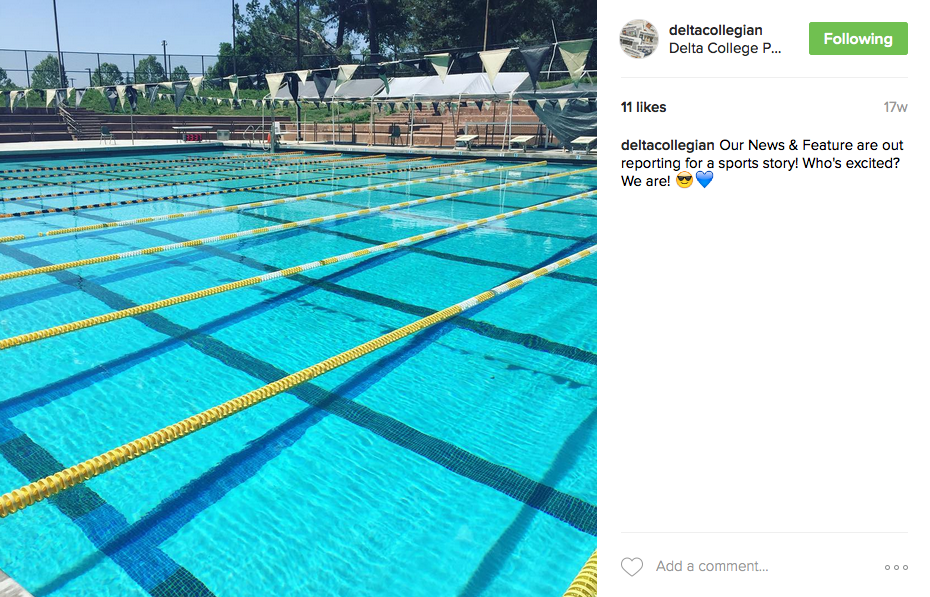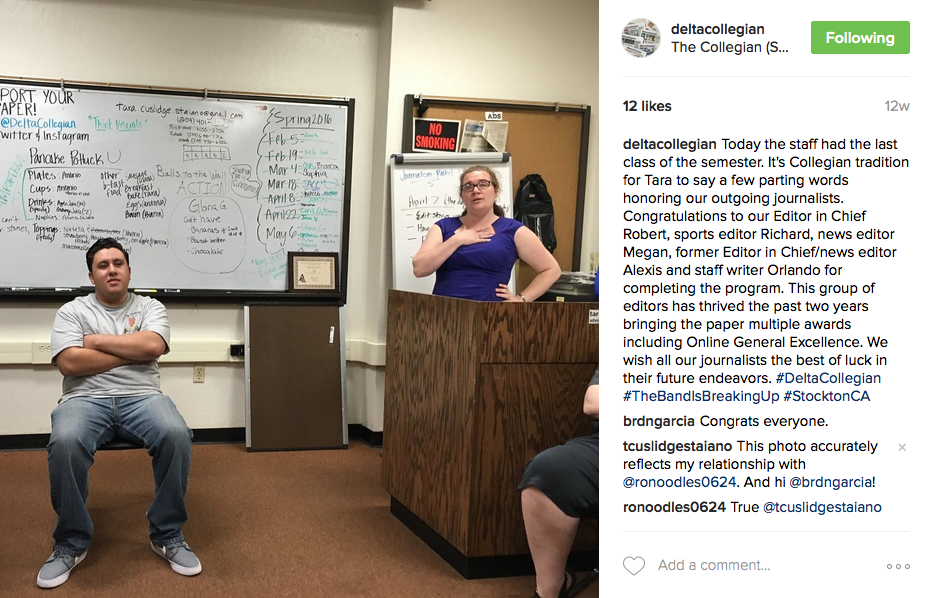Each social media channel for The Collegian has a different theme. For Instagram, we look “behind the scenes” at the reporting that happens during newspaper production.
That means we often talk about what we’re reporting on while we’re reporting, but within reason.
Newspapers don’t allow pre-publication review. That means that NONE of your sources are allowed to read your story before it prints. You can’t give someone a copy “to edit” or “for review.” There are liability and ethical issues in doing so. So the basic premise for Instagram is simple: Give a teaser, but don’t give away the whole story.
And don’t give up huge news lead on the channel.
There are three types of posts that are good contributions to the account.
Teasing upcoming stories

This post doesn’t show much, but it gives reader’s an indication that the staff is working on something about swimming. It could have been strong if the editors Instagram accounts were tagged and if it addressed when the newspaper was coming out.

This post offers an excellent photo, but again doesn’t necessarily address where Sen. Bernie Sanders is speaking. Remember to add details to your social media posts. It’s not enough to just say #StocktonCA, because most of the reporting you’ll do is in Stockton. Why not say Weber Point Events Center in the actual text in addition to the geotag? Give readers context.

Again, this post is a tease, but doesn’t include location. Notice that it’s a screenshot inside the game. You can use approaches like this to make your posts more interesting. Also note the tagging of two other Instagram accounts, the writer’s and a local organization working to put on the event. Anytime you can connect, do so, even if it’s just tagging the San Joaquin Delta College Instagram account (@SJDeltaCollege).
NOTE: When you tease an upcoming story, don’t give away details that only The Collegian has access too. Don’t give up your breaking news.
Inside view of the staff

Newspapers are kind of a mystery to outsides. One way to make them less of one is to give some detail about what we do behind the scenes. Your posts can be as simple as posting from a pitching session. Note the photo above shows the board. You will come to find out that the board is sacred space. We don’t give up what’s on the board. Why? Doing so might cause undue influence on reporters or stories. This photo gives a peek, without revealing too much.

Moments like this happen once a semester, or sometimes once a year. Editors are often just names in the paper. At the end of every school year, the adviser offers tributes to the editors who are leaving The Collegian. These moments, again, personify the newspaper.
What makes a good post
- Showing, not telling: Instagram is about the photo. Don’t just take a picture of the newspaper and call it a day. Capture a moment that reflects that “behind the scenes” quality.
- Connecting with other accounts: Does your photo include a picture of a student you know? Tag that person. Tag Delta College. Tag the team you’re profiling, etc. Connecting increases followers and also allows more viewers into our channel.
- Geotag: Make sure you tag your location. Instagram will always suggest a location. Sometimes your location is just “The Collegian.” That’s OK. Tag it. People will be able to find us then. And yes, we want that.
- Use hashtags: A new generation of digital natives are viewing social media more than other news sources. They connect stories and ideas, and teach the web how to respond, using hashtags. You may create a hashtag for your story, or your reporting. We use #jointhecollegian as much as possible for recruitment.
- Include as much detail as possible: This is a mini story. Address the who, what, where, when, why and how if you can. Don’t leave out a location in the text just because you geotagged a spot. Get the name of a person, which should be a given in journalism.
- Stay active: Don’t just post on your assigned day. You can use The Collegian’s social media channels to build your brand as a reporter with a hashtag. Those posts can be displayed in a digital portfolio. You can use them to show prospective employers that you have social media experience. Don’t lag in this area.